Demolition Begins on Iconic Pier at Seacliff State Beach
Story from: Adeline Yee, Communications and Marketing Division
 Granite Construction began the demolition of the pier at Seacliff State Beach on Monday, March 20. The memorial benches were removed and will be safely kept with State Parks in the interim. Photos from Brian Baer and Adeline Yee, Communications and Marketing Division.
More than two months after atmospheric river storms destroyed more than half of the pier at Seacliff State Beach, demolition officially began on Monday, March 20. Granite Construction will be removing the pier, piece by piece, over the next six weeks until no visible portions of the pier can be seen.
The January storms severely damaged the remaining structure of the pier, originally built in 1930. After State Parks consulted with structural engineers, it was deemed unsafe for the public and necessary to be removed. The storms also caused significant damage to the campgrounds and day-use areas, and left a huge swath of debris on the beach.
About half a dozen media outlets and dozens of local residents with fond memories of the pier showed up for the start of demolition on Monday. Workers removed the memorial benches, which miraculously survived the storms. The lifeguard tower will also be removed in the coming days. State Parks Superintendent II Joe Walters and Senior Interpretive Aide Paul Karz provided interviews and livestreams on the department’s Facebook and Instagram.
Public access will be limited from the waterline to the bluffs during the demolition work: Monday through Friday from 8 a.m. to 4 p.m. Outside of these hours, the public can walk along the paved pathway to view the ongoing work. The visitor center will be open during normal operational hours of 10 a.m. to 4 p.m., Wednesday through Sunday, and after Memorial Day weekend, seven days a week.
While the pier will be removed, the S.S. Palo Alto (Cement Ship) will remain in the ocean, as it has become a natural habitat for marine life since being moored at the end of the pier in the 1930s. As for whether the pier will be rebuilt, that has not been determined at this time, as the department will be carefully considering how to provide recreational facilities more resilient to the effects of climate change and sea level rise.
For more information on the recovery process, please view our press release and visit parks.ca.gov/SeacliffStateBeach.
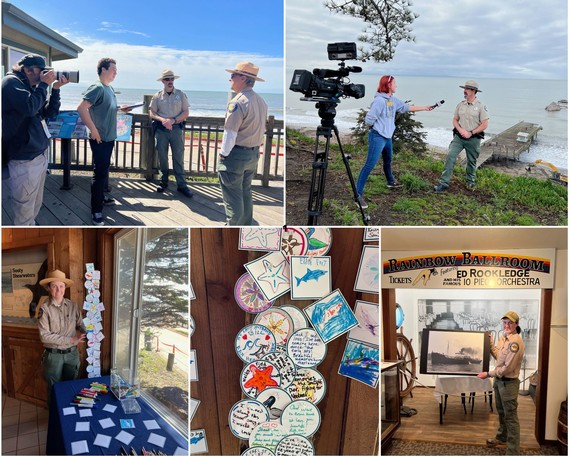 Top left: Senior Interpretive Aide Paul Karz is interviewed by Lookout Santa Cruz reporter Max Chun. Top right: Superintendent II Joe Walters interviewed by KION News. Bottom left: Lead Interpreter I Ashley Wemp stands next to handwritten notes and drawings left by visitors with their memories of Seacliff State Beach. Bottom middle: Close-up of some of the drawings and notes. Bottom right: Ashley holding an old photograph of the SS Palo Alto in the 1930s inside the visitor center. Photos from Adeline Yee, Communications and Marketing Division.
Natural Resources Agency Secretary Wade Crowfoot Visits California Conservation Corps Crews at Colonel Allensworth State Historic Park
Story and photos from: Lori Wear, Great Basin District
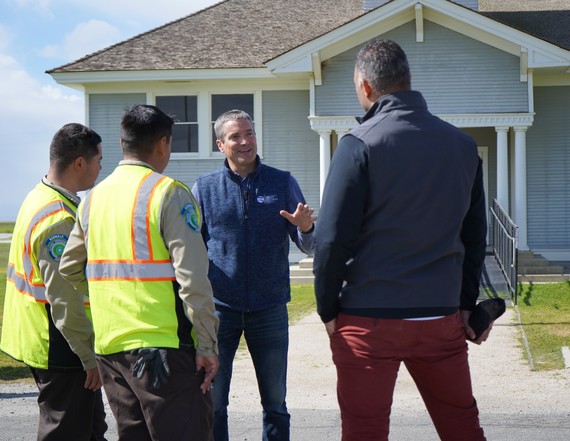 Secretary Crowfoot talks with California Conservation Corps (CCC) crew members and Jarred Patton of CCC in front of the Allensworth Schoolhouse at Colonel Allensworth State Historic Park.
This spring, the California Conservation Corps (CCC) is spiking seven crews for 10 weeks at Colonel Allensworth State Historic Park (SHP). The CCC crews from Fresno, Los Angeles, Placer, Sacramento, San Bernardino and San Diego Counties are working on improvements to the park, including repairing woodwork and painting approximately half of the renovated and reconstructed buildings in the park.
Proposition 68 funding is supporting six of the 10 CCC spikes at Colonel Allensworth SHP by providing equipment and other necessary supplies for this project. The CCC will finish their work just before the park’s cooperating association's, the Friends of Allensworth’s, May fundraising event.
On Wednesday, February 22, Secretary Wade Crowfoot, California Department of Food and Agriculture Secretary Karen Ross, California State Parks Director Armando Quintero, CCC Senior Deputy Director Larry Notheis and other CCC and California State Parks’ staff visited the park to meet the Norwalk CCC crew and tour the historic African American town of Allensworth. California State Parks Senior Architect Amy Schuessler presented information on the new museum/visitor center slated for the park to those in attendance, including members of the Friends of Allensworth and the nonprofit organization the Allensworth Progressive Association. Secretaries Crowfoot and Ross toured the Allensworth Schoolhouse and rang the bell signaling to the group to break for lunch.
Larry spearheaded the collaboration between the CCCs and California State Parks to make this project possible. He introduced the CCC crew leaders and crew from the Norwalk center and explained how he started his career with the CCCs as a crew member, working his way up the ranks to his current position as the senior deputy director. He talked with President of the Friends of Allensworth Sasha Biscoe and offered the services of the CCCs to the park in the future.
California State Parks Director Quintero arrived the day before and spent the evening with the CCC crew members before strong winds forced everyone to find cover. Luckily, the storm passed by morning and the sun was shining with just a light breeze wafting through the wildflowers blooming in the park when the CCC crew began work for the day.
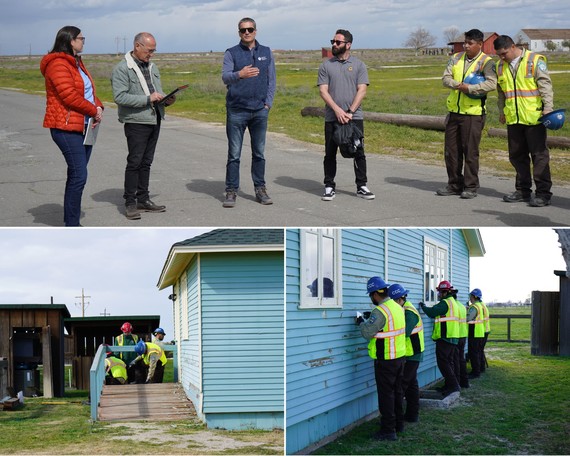 Top: Secretary Wade Crowfoot and Director Armando Quintero with parks staff and CCC Norwalk crew members. Bottom right: CCC Norwalk Crew scraping paint at the Allensworth house. Bottom left: CCC Norwalk crew working on the Americans with Disabilities Act of 1990 (ADA) ramp at the Allensworth house.
Off-Highway Motor Vehicle Recreation Division Teams Up With Superhero Partners to Promote Safety Awareness Week, April 1-9
Story from: Don Schmidt, Off-Highway Motor Vehicle Recreation Division
 For the third year running, the Off-Highway Motor Vehicle Recreation Division (OHMVR) is teaming up with its many partners to educate the off-highway vehicle (OHV) community about recreating safely during OHV Safety Week. The theme for the 2023 OHV Safety Awareness Weeks, set for April 1-9 and November 11-19, is “Be the Off-Road Hero.” This year’s theme promotes the idea of engaging your superpower for OHV safety by Suiting Up (wearing the proper safety gear correctly), Being Visible (using a whip, flag and high-visibility clothing) and Training for a Better Tomorrow (taking a free class to gain a higher level of experience).
“We are asking all OHV enthusiasts to be an OHV hero to others around them by riding respectfully and recreating responsibly,” said OHMVR Division Chief Callan McLaughlin.
OHV Safety Week began in 2021 during the OHMVR Division 50th Anniversary. Its goal is to teach basic safe-operation techniques to all riders and drivers. There are two dedicated weeks, one in the spring and one in the fall, to accommodate the high number of visitors and the wide geographical spread of our state vehicular recreation areas (SVRA) and partner agencies. OHV Safety Awareness Week will include social media posts, live demonstrations, promotional videos and free on-site training classes. Check out the OHMVR Division’s Facebook and Instagram to see all the activities taking place throughout the year.
The OHV community is made up of many individuals and groups dedicated to keeping everyone safe while enjoying California’s incredible OHV recreation opportunities. The division’s primary partner, the California Outdoor Recreation Foundation, works to promote safety, education and sustainable OHV recreation in our SVRAs. Tread Lightly! helped to provide the important safety messaging and graphics for the campaign. The Specialty Vehicle Institute of America and their partner groups, the Motorcycle Safety Foundation, the ATV Safety Institute, and the Recreational Off-Highway Vehicle Association, provide free on-site training opportunities across the state. We also work with the U.S. Forest Service, Bureau of Land Management, California Highway Patrol, Motorcycle Industry Council and many other OHV community groups to promote OHV safety.
Today, there are nine SVRAs across California: Carnegie, Clay Pit, Eastern Kern County Onyx Ranch, Heber Dunes, Hollister Hills, Hungry Valley, Oceano Dunes, Ocotillo Wells and Prairie City. These public lands provide recreational opportunities on approximately 145,000 acres of lands, with more than 600 miles of designated OHV trails and terrain. Some SVRAs also feature camping, swimming and other recreational opportunities, and a variety of wildlife, sensitive habitats, plants and animal species call these areas home.
Bay Area District Staff Particpate in Sonoma County STEM Discovery Day
Story and photo from: Dave Duplantier, Bay Area District
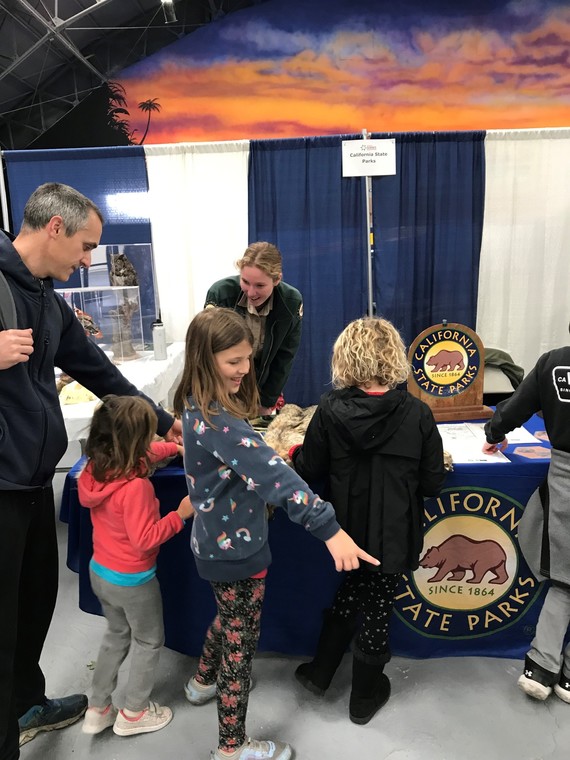 Park Interpretive Specialist Brooke Sullivan engaging some young explorers at the State Parks tables.
California State Parks Bay Area District recently participated in the 2023 North Bay Science Discovery Day in Sonoma County, a community science festival to spark children’s wonder and curiosity for science, technology, engineering and mathematics (STEM). Over 70 exhibitors from various companies, organizations and agencies participated in the event.
The main goal was to inspire young people to pursue STEM education and careers by engaging them with hands-on STEM activities and continuing to work collaboratively with educators and employers, supporting the next generation’s interest and curiosity. The many organizations, agencies and companies are working together to develop an engaging and growing interest in STEM careers toward the goal of building of a global competitive workforce and increasing the regions' and state’s economic vitality.
The State Parks display consisted of various wildlife found in our parks and open space areas. It featured replica skulls, pelts, antlers, synthetic snakes and pictures of wildlife. Additionally, we had real taxidermy of red-tailed hawk and a great horned owl. A special exhibit featured an authentic juvenile black bear skin, as well as replica skull, paw molds and scat for attendees to study and appreciate. Finally, each youth attendee received a State Parks sticker and a small bag of polished natural stones to remember their experience at the exhibit.
Park Interpretive Specialists Brooke Sullivan and Dave Duplantier were kept busy all day with over 400 visitors to the tables and exhibit.
Railroad Museum and Foundation Kick Off 40th Consecutive Season of Weekend Excursion Trains
Story from: California State Railroad Museum Foundation
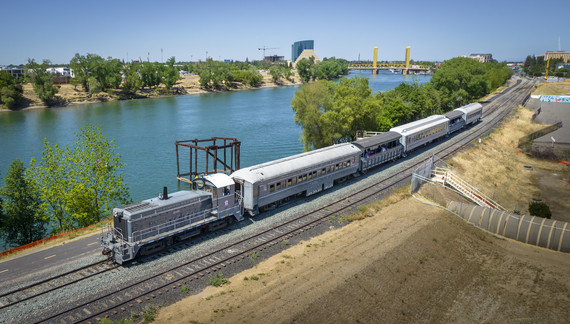
Image of a previous excursion train ride along the Sacramento Southern Railroad. Photo courtesy of Kelly B. Houston.
Presenting the only train ride experience behind an authentic, historic locomotive in the Sacramento region, the California State Railroad Museum and the California State Railroad Museum Foundation are proud to announce the 40th consecutive season of popular weekend excursion train rides on the Sacramento Southern Railroad that start the April 1-2 weekend. While some preseason train rides are already available on a limited basis, a total of five train rides will be available each weekend day beginning with the official kickoff of the season. Also, starting Friday, April 7, three excursion train rides will also be available on Fridays.
Train ride guests have the option to ride in open-air gondolas with bench seating or in comfortable and cushioned, enclosed coach cars. Excursion train ride guests delight in the sights, smells and sounds of an authentic, historic locomotive as it rolls along the levees of the Sacramento River for a 6-mile, 50-minute round-trip excursion. Appealing to all ages, the experience offers guests the chance to enjoy train travel from an earlier era.
Weekend excursion train ride tickets are limited and interested riders are encouraged to book online in advance. If still available, weekend excursion train ride tickets can be purchased in person starting at 9 a.m. the day of the train ride. All Tuesday/Thursday tickets are only available day-of at the Central Pacific Railroad Passenger Station (on Front Street, between I and J Streets). All weekday and weekend excursion trains depart from the Passenger Station.
Preseason train rides are available on weekends at 11:30 a.m., 1 p.m. and 2 p.m. through March, and on Tuesdays and Thursdays at 11:30 a.m. and 1 p.m. through April. Beginning opening weekend on April 1-2, train rides depart on weekends at 10 a.m., 11:30 a.m., 1 p.m., 2:30 p.m. and 4 p.m. during the official season. On Fridays, excursion trains depart at 11:30 a.m., 1 p.m. and 2:30 p.m.
All regular/coach excursion train tickets cost $15 for adults, $8 for youths (ages 6-17) and ages five and under ride free. For passengers desiring a first-class train ride experience (also starting April 1-2), tickets cost $25 for adults, $18 for youths and are free for children five and under. First-class train tickets often sell out early so guests are encouraged to purchase tickets in advance. All California State Railroad Museum Foundation members receive free regular/coach train rides and discounted First Class experiences, based on availability.
To purchase weekend excursion train ride tickets or for more information about the California State Railroad Museum or the Foundation in general, please visit californiarailroad.museum.
Great Basin District Repatriates Artifacts
Story and photos from: Steven Ptomey, Great Basin District
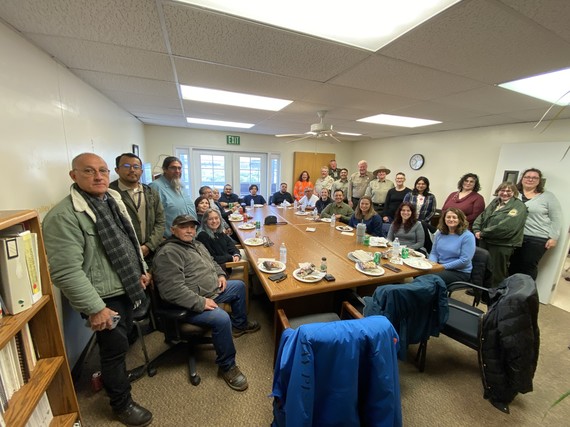 Group that helped with the repatriation of artifacts on state park land in the Great Basin District.
It all started with a phone call and ended a few months later with a group of 35 people present for a repatriation ceremony and reinternment of precontact artifacts in their homeland. That homeland happens to be part of a state park.
In November State Parks' Great Basin District cultural resource staff responded to an inquiry from Caltrans District 7 (Los Angeles) about the possibility of reburying artifacts that were excavated as part of a highway-widening project. The local tribal governments, the Yuhaaviatam of San Manuel Nation, the Fernandeño Tataviam Band of Mission Indians and their cultural staff, expressed a concern that if Caltrans simply moved the objects to another portion of the project area, they would be disturbed again by a future highway project. They reached out to State Parks since there were several parks nearby. A couple of virtual meetings and one field meeting was all it took for all parties to agree on a location for the reburial. Waiting on the weather on the other hand was a bigger challenge.
With help from the Hungry Valley State Vehicular Recreation Area Trails crew and the District Environmental Science staff, an undisclosed location was prepared with a 1x2 meter exaction unit and a small fire ring as requested by our Tribal partners. Part of the ceremony conducted by the Tribal representatives involved the removal of the artifacts from their boxes, bags and other packaging, to be placed in direct contact with the soil. Once that was done, and small thin layer of dirt was in place, modern coins were placed into the unit to mark it as a recent reburial and not an archaeological site in its own right. Then a thicker layer of dirt was placed along with embers from the fire.
At this point State Parks staff, including Director Quintero and District Superintendent Russ Dingman, and Caltrans staff (archaeologists and senior managers) were invited to take part and help refill the excavation unit. The location is logged and documented with State Parks and will be part of the Cultural Resources Database, so not be disturbed in the future.
Despite driving winds, stinging rain and the cold, the group were in high spirits and felt that not only were they part of something important, but also something that was personally satisfying. After the ceremony was concluded, the rain stopped and the sun made a much-welcomed appearance. The group all reconvened indoors at the Great Basin District Office to share a meal, provided by Far Western, the contract cultural resource firm that conducted the original excavation and evaluation of the sites.
This successful collaboration exemplifies the new way we are working together to improve relations between state government and our Tribal partners.
2022 Governor’s Historic Preservation Awards Ceremony is Live, Online, March 30
Story from: Office of Historic Preservation
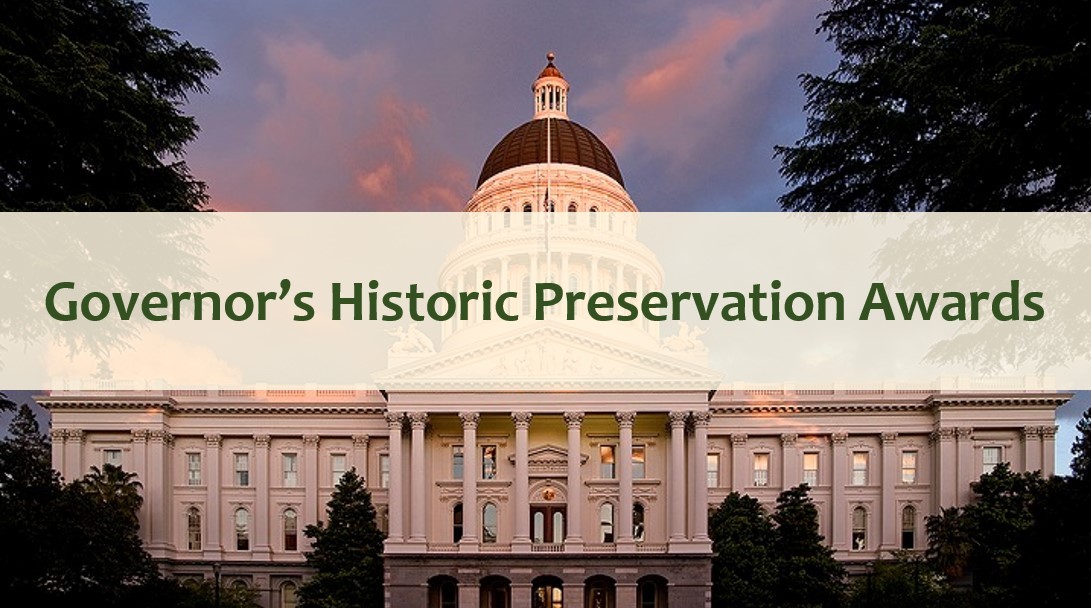 The Office of Historic Preservation (OHP) and California State Parks will have the pleasure of hosting the 2022 Governor’s Historic Preservation Awards ceremony on Thursday, March 30. State Historic Preservation Officer (SHPO) Julianne Polanco and Director of California State Parks Armando Quintero will present the awards beginning at 1 p.m. and livestream on the OHP Facebook page and YouTube channel.
As in years past, the 2022 awardees represent the dedicated and innovative efforts going on throughout California to preserve, educate about and celebrate our state’s broad and diverse heritage. The 2022 awards range from the rehabilitation of historic buildings to the use of a podcast format to further the mission and work of historic preservation:
Please join us online as we celebrate these outstanding achievements.
 Clockwise from upper left: Old Orange County Courthouse, Angel Island Immigration Station Hospital, “Save As: NextGen Heritage Conservation” podcast, SMUD Headquarters Building and First Congregational Church of Long Beach. Photos from Orange County Parks, Garavaglia Architecture Inc., Cindy Olnick, University of Southern California, Dreyfuss + Blackford, and John Fidler Preservation Technologies, respectively.
California State Park Adventure Pass Day at Colonel Allensworth State Historic Park
Story and photos from: Lori Wear, Great Basin District
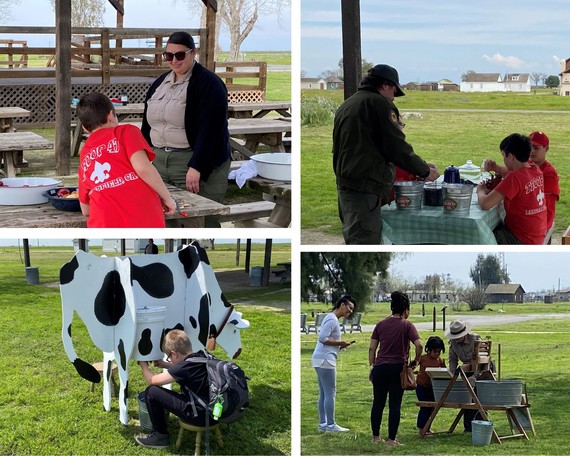 Top left: Senior Park Aide Sara Lua-Lopez shows a Boy Scout from Troop 47 how to peel and core apples to make a pie. Top right: State Park Interpreter I Dorian Yarnelson shows Boy Scouts from Troop 47 how to grind coffee without electricity. Bottom left: Milking a cow was one of the chores many children in Allensworth did daily. Bottom right: State Park Interpreter I Jerelyn Oliveira demonstrates washing clothes on an old-fashioned washboard.
Are you ready for an adventure? Colonel Allensworth State Historic Park hosted the first California State Park Adventure Pass Day on Saturday, March 18.
The California State Park Adventure Pass provides free entry to fourth graders and their families at 19 select state parks. This event, featuring eight living history activities and docent-led interpretation of the historic African American town of Allensworth, brought new passholders from the San Joaquin Valley to the park.
Boy Scout Troop 47 from Bakersfield, California, reserved the campground over the weekend and enjoyed the beautiful, sunny weather while attending the event. ABC30 News from Fresno, California, featured the Adventure Pass Day in a story on its evening broadcast.
The event was a success and will be held again next year.
Gold Fields District to Celebrate Earth Day 2023 With Restoration Project at Folsom Lake State Recreation Area
Story from: Devin Swartwood, Gold Fields District
 Having events and celebrations is fun, but it is always better with like-minded partners. Gold Fields District has historically received grant funding from our friends at the California State Parks Foundation, and the district was fortunate to be a recipient of grant funding in 2023 for an Earth Day event. This year, the district and California State Parks Foundation (CSPF) are bringing our friends and partners together to kick off a restoration project at Folsom Lake State Recreation Area to celebrate Earth Day.
The project will restore an area at Black Miners Bar back to native plant species and, specifically, the important oak woodlands. This will strengthen our fire resiliency and improve the native ecosystem. Ninety volunteers will be planting native trees and shrubs and helping to run drip lines to ensure the trees survive.
With 90 volunteers, we know that more people will wander in and want to see what the crowd is up to. Since we encourage curiosity, the district will have booths set up to educate visitors about Earth Day, trail etiquette, stewardship, State Parks recruitment, treading lightly, water safety, natural resource interpretation, cultural resource interpretation and much more. This may seem like a wide array of topics, but there is so much to do and talk about within Gold Fields District.
This leads us to ask the question, “What’s your Adventure?” Whatever it may be, you can find it within the beautiful and diverse parks in Gold Fields District. Earth Day 2023 will be an adventure we will all celebrate.
Click here to learn more about Earth Day Climate Action with the California State Parks Foundation.
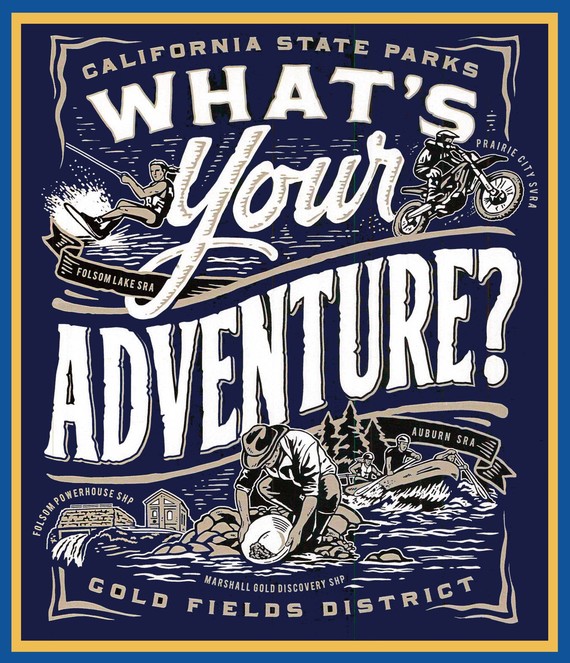 International Partners Join State Historic Preservation Office for Tour of Border Field State Park to Further Cultural Heritage Climate Vulnerability Assessments
Story from: Julianne Polanco, Office of Historic Preservation
 The group listens to a presentation by State Parks Manager of the Tijuana River National Estuarine Research Reserve Chris Peregrin about the attributes of Border Field State Park. Photo from Andrew Potts, Climate Heritage Network.
As the effects of climate change are becoming more extreme, historic and cultural heritage sites are increasingly at risk. The University of California, San Diego, Department of Anthropology and Scripps Institute and the State Office of Historic Preservation are collaborating to develop a cultural heritage-centered climate vulnerability assessment framework. The goal is to create a path for stakeholders—Tribal nations, adjacent communities, land stewards and other interested parties—to create a values definition to assess, together, the climate vulnerability of a site to help support local implementation of science and traditional ecological knowledge-based, community-centered climate vulnerability assessments.
As part of the second phase of this effort, a group of international experts working with the National Geographic Society’s Preserving Legacies project gathered for a two-day seminar last week for participants to share, listen and learn from other. Primarily UNESCO World Heritage site stewards, participants had the opportunity to consider ways to adapt these types of assessments to be more effective in meeting local needs and to accelerate greater action.
Preserving Legacies is a project also focused on protecting threatened cultural heritage sites from the effects of climate change. It is missioned to create a program for significant cultural heritage sites around the world to understand future climate impacts and create adaptation and mitigation plans to aid in managing these sites in a more sustainable and holistic way.
Through the lens of Chris Peregrin and staff of the Tijuana River National Estuarine Research Reserve, Border Field State Park, the group learned about this special habitat comprised of sand dunes and salt marshes, a refuge to a variety of threatened species of birds. But birds are not the only thing at risk at Border Field. It is a complex and multilayered site with many values of the built environment—a national marine estuary, ancestral lands of the Kumeyaay peoples, social considerations, historical resources—all in a changing environment adjacent to the U.S.-Mexico border. The exchange added to the conversation, provided an on-the-ground opportunity to experience extreme weather in situ and elicited thoughtful dialogue about possible solutions, giving partners a broader understanding of how to consider action at their own sites more deeply. These exchanges are so important to working together to steward important cultural heritage sites into the future for all communities, in California and globally.
The Office of Historic Preservation is deeply appreciative to Chris, the staff at Border Field State Park and all the partners for this experience.
 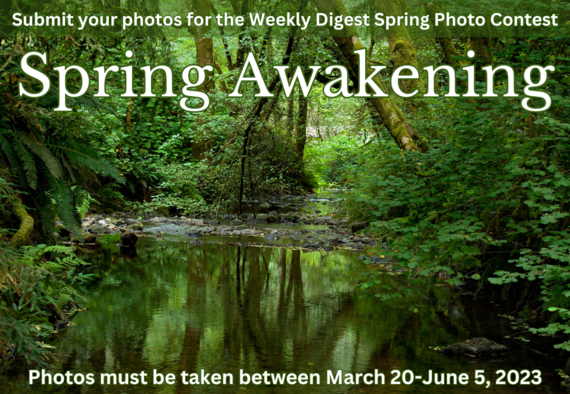 Email photos to the WeeklyDigest@parks.ca.gov.
  The Weekly Digest will be on hiatus on Friday, March 31, in observance of César Chávez Day. The next edition will be on Friday, April 7.

|